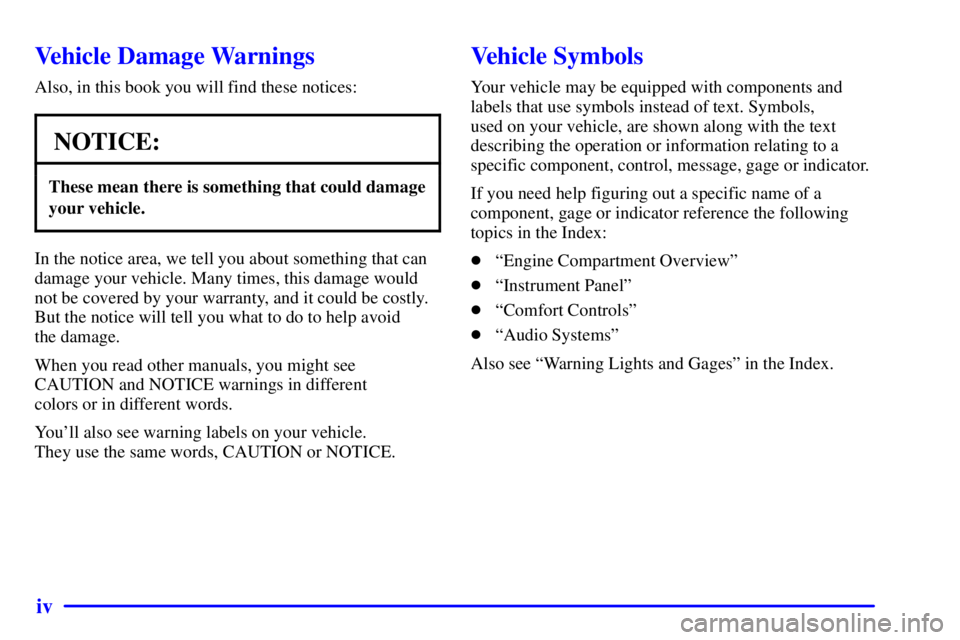Page 5 of 427

iv
Vehicle Damage Warnings
Also, in this book you will find these notices:
NOTICE:
These mean there is something that could damage
your vehicle.
In the notice area, we tell you about something that can
damage your vehicle. Many times, this damage would
not be covered by your warranty, and it could be costly.
But the notice will tell you what to do to help avoid
the damage.
When you read other manuals, you might see
CAUTION and NOTICE warnings in different
colors or in different words.
You'll also see warning labels on your vehicle.
They use the same words, CAUTION or NOTICE.
Vehicle Symbols
Your vehicle may be equipped with components and
labels that use symbols instead of text. Symbols,
used on your vehicle, are shown along with the text
describing the operation or information relating to a
specific component, control, message, gage or indicator.
If you need help figuring out a specific name of a
component, gage or indicator reference the following
topics in the Index:
�ªEngine Compartment Overviewº
�ªInstrument Panelº
�ªComfort Controlsº
�ªAudio Systemsº
Also see ªWarning Lights and Gagesº in the Index.
Page 64 of 427

2-
2-1
Section 2 Features and Controls
Here you can learn about the many standard and optional features on your vehicle, and information on starting,
shifting and braking. Also explained are the instrument panel and the warning systems that tell you if everything is
working properly
-- and what to do if you have a problem.
2
-2 Windows
2
-4 Keys
2
-6 Door Locks
2
-13 Remote Keyless Entry System (If Equipped)
2
-18 Trunk
2
-20 Theft
2
-21 Universal Theft-Deterrent (If Equipped)
2
-23 PASS-Key�III
2
-26 New Vehicle ªBreak-Inº
2
-26 Ignition Positions
2
-28 Starting Your Engine
2
-29 Engine Coolant Heater (If Equipped)
2
-30 Automatic Transaxle Operation
2
-33 Parking Brake
2
-34 Shifting Into PARK (P)
2
-37 Shifting Out of PARK (P)
2
-38 Parking Over Things That Burn
2
-38 Engine Exhaust2
-39 Running Your Engine While You're Parked
2
-40 Tilt Wheel
2
-40 Turn Signal/Multifunction Lever
2
-47 Exterior Lamps
2
-51 Interior Lamps
2
-55 Mirrors
2
-57 Storage Compartments
2
-59 Air Inflator System (Option)
2
-62 OnStar� System (If Equipped)
2
-65 Express Sunroof (Option)
2
-66 HomeLink� Transmitter (If Equipped)
2
-70 The Instrument Panel -- Your
Information System
2
-76 Warning Lights, Gages and Indicators
2
-96 Driver Information Center (DIC)
(If Equipped)
2
-109 Head-Up Display (HUD) (Option)
Page 90 of 427

2-27
ACC (Accessory): In this position you can operate your
electrical accessories such as power windows, sunroof
(option), audio system and windshield wipers.
ON: This is the position the switch returns to after you
start your engine and release the switch. Even when the
engine is not running, you can use ON to operate your
electrical accessories and to display some instrument
panel cluster warning lights. This is the position for
driving your vehicle.
START: This position starts the engine. When the
engine starts, release the key. The ignition switch will
return to ON for normal driving.
Even if the engine is not running, ACC and ON
are positions that allow you to operate your
electrical accessories.Key Reminder Warning
If you leave your key in OFF you will hear a warning
tone when you open the driver's door.
Retained Accessory Power (RAP)
After you turn the ignition off and remove the key, you
will still have power to such accessories as the radio,
sunroof (option) and power windows for up to
10 minutes. Power is turned off if you open a door.
Always leave your key in OFF. If you leave your key
in any position other than OFF, your battery will
discharge prematurely.
Page 110 of 427
2-47
Exterior Lamps
The lever on the left side of the steering column
operates the exterior lamps.
: Turn the outside part of the lever with the symbol
on it, to operate the lamps.The exterior lamp switch has three positions:
OFF: Turning the switch to this position turns
off all lamps and lights, except the Daytime
Running Lamps (DRL).
(Parking Lamps): Turning the switch to
this position turns on the parking lamps, together
with the following:
�Sidemarker Lamps
�Taillamps
�License Plate Lamps
�Instrument Panel Lights
(Headlamps): Turning the switch to this position
turns on the headlamps, together with the previously
listed lamps and lights.
Page 114 of 427

2-51
Interior Lamps
Instrument Panel Brightness Control
When it is dark outside, you can brighten or dim your
instrument panel cluster lights using the DIM knob,
located to the left of the steering wheel on the
instrument panel.
Turn the knob clockwise to brighten the instrument
panel cluster lights and displays. Turn the knob
clockwise all the way to turn on the interior courtesy
lamps. Turn the knob counterclockwise to dim the
instrument panel cluster lights and displays and to turn
off the courtesy lamps.
Courtesy Lamps
If it is dark enough outside, when any door is opened,
several lamps will come on. They make it easier for you
to enter and leave the vehicle. Turn the dimmer knob all
the way clockwise to turn the interior courtesy lamps on.
Illuminated Entry
If it is dark enough outside and you press the button
with the unlock symbol on the remote keyless entry
transmitter (if equipped), the interior courtesy lamps
will come on and stay on for approximately 25 seconds.
The lamps will turn off immediately by pressing the
button with the lock symbol on the remote keyless entry
transmitter, by turning the ignition key to ON or by
activating the power door locks.
If a door is left ajar, your interior lamps will turn off
after 10 minutes to save your battery.
Delayed Entry Lighting
When you open the door to enter your vehicle, the
interior lamps will come on if it is dark enough outside.
When you close the door with the ignition off, the
interior lamps will stay on for 25 seconds or until the
ignition is turned on. Locking the doors with the
power door lock switch, or with the lock button on the
remote keyless entry transmitter (if equipped), will
override the delayed entry lighting and the lamps will
turn off immediately.
Page 135 of 427
2-72
Instrument Panel Clusters
The instrument panel clusters are designed to let you know at a glance how your vehicle is running. You'll know how
fast you're going, how much fuel you're using, and many other things you'll need to drive safely and economically.
Your vehicle is equipped with one of these instrument panel clusters, which includes indicator warning lights and
gages that are explained on the following pages.
Standard Cluster (United States version shown, Canada similar)
Page 139 of 427
2-76
Tachometer
The tachometer shows your
engine speed in revolutions
per minute (rpm).
NOTICE:
Do not operate the engine with the tachometer in
the shaded area or engine damage may occur.
Warning Lights, Gages
and Indicators
This part describes the warning lights and gages that
may be on your vehicle. The pictures will help you
locate them.
Warning lights and gages can signal that something is
wrong before it becomes serious enough to cause an
expensive repair or replacement. Paying attention to
your warning lights and gages could also save you or
others from injury.
Warning lights come on when there may be or is a
problem with one of your vehicle's functions. As you
will see in the details on the next few pages, some
warning lights come on briefly when you start the
engine just to let you know they're working. If you are
familiar with this section, you should not be alarmed
when this happens.
Page 140 of 427

2-77
Gages can indicate when there may be or is a problem
with one of your vehicle's functions. Often gages and
warning lights work together to let you know when
there's a problem with your vehicle.
When one of the warning lights comes on and stays on
when you are driving, or when one of the gages shows
there may be a problem, check the section that tells you
what to do about it. Please follow this manual's advice.
Waiting to do repairs can be costly
-- and even
dangerous. So please get to know your warning lights
and gages. They're a big help.
Your vehicle may also have a Driver Information Center
(DIC) that works along with the warning lights and
gages. See ªDriver Information Centerº in the Index.
The volume of your vehicle's warning chimes can be
adjusted. For more information see ªChime Level
Adjustmentº in the Index.
Safety Belt Reminder Light
When the key is turned to ON or START, a chime will
come on for about eight seconds to remind people to
fasten their safety belts.
The safety belt light will
also come on and stay on
for about 20 seconds, then
flash for about 55 seconds.
If the driver's belt is already buckled, the light will
come on briefly, but the chime will not sound.